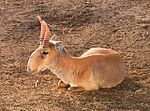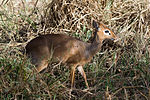Antilopinae
| Antilopinae | |
|---|---|

| |
| Blackbuck (Antilope cervicapra) | |
| Scientific classification | |
| Domain: | Eukaryota |
| Kingdom: | Animalia |
| Phylum: | Chordata |
| Class: | Mammalia |
| Order: | Artiodactyla |
| Family: | Bovidae |
| Subfamily: | Antilopinae Gray, 1821 |
| Genera | |
|
See text. | |
The Antilopines are even-toed ungulates belong to the family Bovidae. The members of Antilopini (gazelles, blackbucks, springboks, gerenuks, dibatags, and Central Asian gazelles) are often referred to as true antelopes, and are usually classified as the only living representatives of the Antilopinae. True antelopes occur in much of Africa and Asia, with the highest concentration of species occurring in East Africa in Sudan, Eritrea, Ethiopia, Somalia, Kenya, and Tanzania. The saigas and Tibetan antelopes are related to true antelopes (Antilopinae) and sheep and goats (Caprinae), but are often placed in their own subfamily, Saiginae.[citation needed] These animals inhabit much of central and western Asia. The dwarf antelopes are sometimes placed in a separate subfamily, Neotraginae, and live entirely in sub-Saharan Africa. The Antilopinae are a subfamily of Bovidae that roam the East African savannas and deserts and they have acclimated to possess wider insertion muscles to enable them to avoid predators in the open savanna.[citation needed]
Classification
Family Bovidae
- Subfamily Antilopinae
- Tribe Antilopini
- Genus Ammodorcas
- Dibatag Ammodorcas clarkei
- Genus Antidorcas
- Springbok Antidorcas marsupialis
- Genus Antilope
- Blackbuck Antilope cervicapra
- Genus Eudorcas

Thomson's gazelle (Eudorcas thomsoni) - Mongalla gazelle Eudorcas albonotata
- Red gazelle Eudorcas rufina †
- Red-fronted gazelle Eudorcas rufrifrons
- Thomson's gazelle Eudorcas thomsoni
- Heuglin's gazelle Eudorcas tilonura
- Genus Gazella
- Subgenus Deprezia
- Subgenus Gazella

Mountain gazelle (Gazella gazella) - Arabian gazelle Gazella arabica
- European gazelle Gazella borbonica †
- Chinkara or Indian gazelle Gazella benettii
- Queen of Sheba's gazelle Gazella bilkis †
- Dorcas gazelle Gazella dorcas
- Mountain gazelle Gazella gazella
- Saudi gazelle Gazella saudiya †
- Speke's gazelle Gazella spekei
- Subgenus Trachelocele
- Cuvier's gazelle Gazella cuvieri
- Rhim gazelle or slender-horned gazelle Gazella leptoceros
- Goitered gazelle Gazella subgutturosa
- Genus Litocranius

Gerenuk (Litocranius walleri) - Gerenuk Litocranius walleri
- Genus Nanger
- Dama gazelle Nanger dama
- Grant's gazelle Nanger granti
- Soemmerring's gazelle Nanger soemmerringii
- Genus Procapra
- Zeren Procapra gutturosa
- Goa Procapra picticaudata
- Przewalski's gazelle Procapra przewalskii
- Genus Ammodorcas
- Tribe Saigini

Saiga (Saiga tatarica) - Tribe Neotragini
- Genus Dorcatragus

Kirk's dik-dik (Madoqua kirkii) - Beira Dorcatragus megalotis
- Genus Madoqua
- Günther's dik-dik Madoqua guntheri
- Kirk's dik-dik Madoqua kirkii
- Silver dik-dik Madoqua piacentinii
- Salt's dik-dik Madoqua saltiana
- Genus Neotragus
- Royal antelope Neotragus pygmaeus
- Genus Oreotragus
- Klipspringer Oreotragus oreotragus
- Genus Ourebia
- Oribi Ourebia ourebi
- Genus Raphicerus
- Steenbok Raphicerus campestris
- Cape grysbok Raphicerus melanotis
- Sharpe's grysbok Raphicerus sharpei
- Genus Dorcatragus
- Tribe Antilopini
Fossil genera[1]
- †Demecquenemia
- †Deprezia
- †Dytikodorcas
- †Hispanodorcas
- †Homoiodorcas
- †Majoreas
- †Nisidorcas
- †Ouzocerus
- †Parantidorcas
- †Parastrepsiceros[2]
- †Praemadoqua[3]
- †Prostrepsiceros
- †Sinapodorcas
- †Tyrrhenotragus
References
- ^ "Antilopini". Biolib.
- ^ Kostopoulos, D. (1998). "Parastrepsiceros koufosi n. sp. (Mammalia: Bovidae); note on the possible presence of a Prostrepsiceros descendant in the latest Pliocene of northern Greece". Biology Acta Zoologica Cracoviensia.
- ^ "Praemadoqua". Fossilworks.





